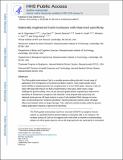| dc.contributor.author | Slaymaker, Ian | |
| dc.contributor.author | Gao, Linyi | |
| dc.contributor.author | Zetsche, Bernd | |
| dc.contributor.author | Scott, David Arthur | |
| dc.contributor.author | Yan, Winston Xia | |
| dc.contributor.author | Zhang, Feng | |
| dc.date.accessioned | 2016-05-22T23:25:15Z | |
| dc.date.available | 2016-05-22T23:25:15Z | |
| dc.date.issued | 2015-12 | |
| dc.date.submitted | 2015-09 | |
| dc.identifier.issn | 0036-8075 | |
| dc.identifier.issn | 1095-9203 | |
| dc.identifier.uri | http://hdl.handle.net/1721.1/102582 | |
| dc.description.abstract | The RNA-guided endonuclease Cas9 is a versatile genome-editing tool with a broad range of applications from therapeutics to functional annotation of genes. Cas9 creates double-strand breaks (DSBs) at targeted genomic loci complementary to a short RNA guide. However, Cas9 can cleave off-target sites that are not fully complementary to the guide, which poses a major challenge for genome editing. Here, we use structure-guided protein engineering to improve the specificity of Streptococcus pyogenes Cas9 (SpCas9). Using targeted deep sequencing and unbiased whole-genome off-target analysis to assess Cas9-mediated DNA cleavage in human cells, we demonstrate that “enhanced specificity” SpCas9 (eSpCas9) variants reduce off-target effects and maintain robust on-target cleavage. Thus, eSpCas9 could be broadly useful for genome-editing applications requiring a high level of specificity. | en_US |
| dc.description.sponsorship | Massachusetts Institute of Technology. Simons Center for the Social Brain | en_US |
| dc.description.sponsorship | National Institute of General Medical Sciences (U.S.) (T32GM007753) | en_US |
| dc.description.sponsorship | Paul & Daisy Soros Fellowships for New Americans (New York, N.Y.) | en_US |
| dc.description.sponsorship | National Institute of Mental Health (U.S.) (5DP1-MH100706) | en_US |
| dc.description.sponsorship | National Institute of Mental Health (U.S.) (1R01MH110049) | en_US |
| dc.description.sponsorship | National Institute of Diabetes and Digestive and Kidney Diseases (U.S.) (5R01DK097768-03) | en_US |
| dc.description.sponsorship | National Science Foundation (U.S.) (Waterman Award) | en_US |
| dc.description.sponsorship | W. M. Keck Foundation | en_US |
| dc.description.sponsorship | New York Stem Cell Foundation | en_US |
| dc.description.sponsorship | Damon Runyon Cancer Research Foundation | en_US |
| dc.description.sponsorship | Kinship Foundation. Searle Scholars Program | en_US |
| dc.description.sponsorship | Merkin Foundation | en_US |
| dc.description.sponsorship | Vallee Foundation | en_US |
| dc.language.iso | en_US | |
| dc.publisher | American Association for the Advancement of Science (AAAS) | en_US |
| dc.relation.isversionof | http://dx.doi.org/10.1126/science.aad5227 | en_US |
| dc.rights | Creative Commons Attribution-Noncommercial-Share Alike | en_US |
| dc.rights.uri | http://creativecommons.org/licenses/by-nc-sa/4.0/ | en_US |
| dc.source | PMC | en_US |
| dc.title | Rationally engineered Cas9 nucleases with improved specificity | en_US |
| dc.type | Article | en_US |
| dc.identifier.citation | Slaymaker, I. M., L. Gao, B. Zetsche, D. A. Scott, W. X. Yan, and F. Zhang. “Rationally Engineered Cas9 Nucleases with Improved Specificity.” Science 351, no. 6268 (January 1, 2016): 84–88. | en_US |
| dc.contributor.department | Harvard University--MIT Division of Health Sciences and Technology | en_US |
| dc.contributor.department | Massachusetts Institute of Technology. Department of Biological Engineering | en_US |
| dc.contributor.department | Massachusetts Institute of Technology. Department of Brain and Cognitive Sciences | en_US |
| dc.contributor.department | McGovern Institute for Brain Research at MIT | en_US |
| dc.contributor.mitauthor | Slaymaker, Ian | en_US |
| dc.contributor.mitauthor | Gao, Linyi | en_US |
| dc.contributor.mitauthor | Zetsche, Bernd | en_US |
| dc.contributor.mitauthor | Scott, David Arthur | en_US |
| dc.contributor.mitauthor | Yan, Winston Xia | en_US |
| dc.contributor.mitauthor | Zhang, Feng | en_US |
| dc.relation.journal | Science | en_US |
| dc.eprint.version | Author's final manuscript | en_US |
| dc.type.uri | http://purl.org/eprint/type/JournalArticle | en_US |
| eprint.status | http://purl.org/eprint/status/PeerReviewed | en_US |
| dspace.orderedauthors | Slaymaker, I. M.; Gao, L.; Zetsche, B.; Scott, D. A.; Yan, W. X.; Zhang, F. | en_US |
| dspace.embargo.terms | N | en_US |
| dc.identifier.orcid | https://orcid.org/0000-0003-2782-2509 | |
| dc.identifier.orcid | https://orcid.org/0000-0002-3067-479X | |
| dc.identifier.orcid | https://orcid.org/0000-0002-2639-9879 | |
| dc.identifier.orcid | https://orcid.org/0000-0002-3579-0327 | |
| dc.identifier.orcid | https://orcid.org/0000-0001-8794-2137 | |
| mit.license | OPEN_ACCESS_POLICY | en_US |
| mit.metadata.status | Complete | |
